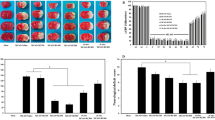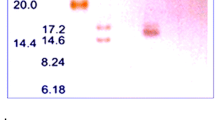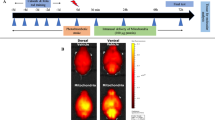Abstract
Erythropoietin, a multitarget molecule exhibited neuroprotective properties, especially against cerebral ischemia. However, little effort has been made to determinate both the administration pathway and doses that diminishes neuronal damage. In this study, we investigate the effect on CA1 region of different intranasal doses of rHuEPO (500, 1000 and 2500 IU/kg) applied in distinct post-damage times (1, 6, and 24 h) against ischemic cellular damage. Furthermore, most effective dose and time were used to evaluate gen and protein expression changes in 3 key molecules (EPO, EPOR, and βcR). We established that CA1-region present histopathological damage in this ischemia model and that rHuEPO protects cells against damage, particularly at 1000 IU dose. Molecular data shows that EPO and EPOR gene expression are upregulated in a short term after damage treatment with rHuEPO (1 h); oppositely, BcR is upregulated in ischemic and Isc + EPO. Protein expression data displays no changes on EPO expression in evaluated times after treatment, but a tendency to increase 24 h after damage; in the opposite way, EPOR is upregulated significantly 6 h after treatment and this effect last until 24 h. So, our data suggest that a single intranasal dose of rHuEPO (1 h post-injury) provides histological neurorestoration in CA1 hippocampal region, even if we did not observe a dose-dependent dose effect, the medium dose evaluated (1000 UI/kg of b.w.) was more effective and sufficient for induces molecular changes that provides a platform for neuroprotection.





Similar content being viewed by others
References
Alcalá-Barraza RS, Lee MS, Hanson LR, McDonald AA, Frey WH II, McLoon LK (2010) Intranasal delivery of neurotrophic factors BDNF, CNTF, EPO, and NT-4 to the CNS. J Drug Target 18:179–190
Arcasoy MO (2008) The non-hematopoietic biological effects of erythropoietin. Br J Haematol 141:14–31
Asadi B, Askari GR, Khorvash F, Bagherpur A, Mahrabi F, Karimi M, Ghasemi M, Najjaran A (2013) Neuroprotective effects of erythropoietin in acute ischemic stroke. Int J Prev Med 4:S306–S312
Baron JC, Yamauchi H, Fujioka M, Endres M (2014) Selective neuronal loss in ischemic stroke and cerebrovascular disease. J Cereb Blood Flow Metab 34:2–18
Bauernfeind AL, Babbitt CC (2017) The predictive nature of transcript expression levels on protein expression in adult human brain. BMC Genomics 18:322
Beleslin-Cokic BB, Cokic VP, Yu X, Weksler BB, Schechter AN, Noguchi CT (2004) Erythropoietin and hypoxia stimulate erythropoietin receptor and nitric oxide production by endothelial cells. Blood. 104:2073–2080
Bernaudin M, Marti HH, Roussel S, Divoux D, Nouvelot A, MacKenzie ET, Petit E (1999) A potential role for erythropoietin in focal permanent cerebral ischemia in mice. J Cereb Blood Flow Metab 19(6):643–651
Brines B, Cerami A (2012) The receptor that tames the innate immune response. Mol Med 18:486–496
Brines ML, Ghezzi P, Keenan S, Agnello D, De Lanerolle NC, Cerami C, Itri LW, Cerami A (2000) Erythropoietin crosses the blood-brain barrier to protect against experimental brain injury. Proc Natl Acad Sci U S A 97:10526–10531
Brines ML, Grasso G, Fiordaliso F, Sfacteria A, Ghezzi P, Fratelli M (2004) Erythropoietin mediates tissue protection through an erythropoietin and common beta-subunit heteroreceptor. Proc Natl Acad Sci U S A 101:14907–14912
Byts N, Sirén AL (2009) Erythropoietin: a multimodal neuroprotective agent. Exp Transl Stroke Med 1:4–12
Cheng NT, Kim AS (2015) Intravenous thrombolysis for acute ischemic stroke within 3 hours versus between 3 and 4.5 hours of symptom onset. Neurohospitalist 5:101–109
Cherian L, Godman JG, Robertson C (2007) Neuroprotection with erythropoietin administration following controlled cortical impact injury in rats. J Pharmacol Exp Ther 322:789–794
Chin K, Oda N, Shen K, Noguchi CT (1995) Regulation of transcription of the human erythropoietin receptor gene by proteins binding to GATA-1 and Sp1 motifs. Nucleic Acids Res 11:3041–3049
Detante O, Jaillard A, Moisan A, Barbieux M, Favre IM, Garambois K, Hommel M, Remy C (2014) Biotherapies in stroke. Rev Neurol 170:779–798
Dietrich WD (2017) Histopathology of cerebral ischemia and stroke. In: Caplan LR, Biller J, Leary MC (eds) Primer on cerebrovascular diseases. Academic Press, London, pp 121–124
Digicaylioglu M, Lipton SA (2001) Erythropoietin-mediated neuroprotection involves cross-talk between Jak2 and NF-κB signaling cascades. Nature 412:641–647
Ehrenreich H, Hasselblatt M, Dembowski C, Cepek L, Lewczuk P, Stiefel M, Rustenbeck HH, Breiter N, Jacob S, Knerlich F, Bohn M, Poser W, Rüther E, Kochen M, Gefeller O, Gleiter C, Wessel TC, de Ryck M, Itri L, Prange H, Cerami A, Brines M, Sirén AL (2002) Erythropoietin therapy for acute stroke is both safe and beneficial. Mol Med 8:495–505
Ehrenreich H, Weissenborn K, Prange H, Schneider D, Weimar C, Wartenberg K, Schellinger PD, Bohn M, Becker H et al (2009) Recombinant human erythropoietin in the treatment of acute ischemic stroke. Stroke 40:647–656
Falcone JA, Salameh TS, Yi X, Cordy BJ, Mortell WG, Kabanov AV, Banks WA (2014) Intranasal administration as a route for drug delivery to the brain: evidence for unique pathway for albumin. J Pharmacol Exp Ther 351:54–60
Fishbane S, Besarab A (2007) Mechanism of increased mortality risk with erythropoietin treatment to higher hemoglobin targets. Clin J Am Soc Nephrol 2:1274–1282
Fisher JW (2003) Erythropoietin: physiology and pharmacology update. Exp Biol Med (Maywood) 228:1–14
Fugate JE, Giraldo EA, Rabinstein AA (2010) Thrombolysis for cerebral ischemia. Front Neurol 1:1–7
Gao Y, Mengana Y, Cruz YR, Muñoz A, Testé IS, García JD, Wu Y, García-Rodríguez JC et al (2011) Different expression patterns of Ngb and EPOR in the cerebral cortex and hippocampus revealed distinctive therapeutic effects of intranasal delivery of neuro-EPO for ischemic insults to the gerbil brain. J Histochem Cytochem 59:214–227
García-Rodríguez JC, Sosa-Teste I (2009) The nasal route as a potential pathway for delivery of erythropoietin in the treatment of acute ischemic stroke in humans. Sci World J 9:970–981
Gorio A, Gokmen N, Erbayraktar S, Yilmaz O, Madaschi L, Cichetti C, Di Giulio MA, Vardar E et al (2002) Recombinant human erythropoietin counteracts secondary injury and markedly enhances neurological recovery from experimental spinal cord trauma. Proc Natl Acad Sci U S A 99:9450–9455
Greenbaum D, Colangelo C, Williams K, Gerstein M (2003) Comparing protein abundance and mRNA expression levels on a genomic scale. Genome Biol 4:117
Harukini I, Bhardwaj A (2006) Mechanism of brain injury after global cerebral ischemia. Neurol Clin 24:1–21
Jelkmann W (2005) Effects of erythropoietin on brain function. Curr Pharm Biotechnol 6:65–79
Jubinsky PT, Krijanovski OI, Nathan DG, Tavernier J, Sieff CA (1997) The beta chain of the interleukin-3 receptor functionally associates with the erythropoietin receptor. Blood. 90:1867–1873
Kågström E, Smith ML, Siesjö BK (1983) Local cerebral blood flow recovery period following complete cerebral ischemia in the rat. J Cereb Blood Flow Metab :170–182
Kellert BA, McPherson RJ, Juul SE (2007) A comparison of high-dose recombinant erythropoietin treatment regimens in brain-injured neonatal rats. Pediatr Res 61:451–455
Kilic E, Kilic U, Soliz J, Bassetti CL, Gassmann M, Hermann DM (2005) Brain-derived erythropoietin protects from focal cerebral ischemia by dual activation of ERK-1/-2 and Akt pathways. FASEB J 19:2026–2028
Kirkeby A, Torup L, Bochsen L, Kjalke M, Abel K, Theilgaard-Monch K, Johansson PI, Bjørn SE et al (2008) High-dose erythropoietin alters platelet reactivity and bleeding time in rodents in contrast to the neuroprotective variant carbamyl-erythropoietin (CEPO). Thromb Haemost 99:720–728
Koehler RC (1997). Large animal models of focal and global cerebral ischemia. In: Ginsberg MD, Bogousslavsky J (eds) Cerebrovascular Disease: Pathophysiology, Diagnosis and Management. Oxford, Blackwell Science, pp 36-51
La Ferla K, Reimann C, Jelkmann W, Hellwig-Bürgel T (2002) Inhibition of erythropoietin gene expression signaling involves the transcription factors GATA-2 and NF-kappaB. FASEB J 16:1811–1813
Lagarto-Parra A, García-Rodríguez JC (2012) Nasal neuro EPO could be reliable choice for neuroprotective stroke treatment. Cent Nerv Syst Agents Med Chem 12:60–68
Lamon S, Russell A (2013) The role and regulation of erythropoietin (EPO) and its receptor in skeletal muscle: how much do we really know? Front Physiol 4:176
Lee HCR, Lee HHM, Wu CYC, Couto e Silva A, Possoit EH, Hsieh T-H, Minagar A, Lin HW (2018) Cerebral ischemia and neurodegeneration. Neural Regen Res 13(3):373–385
Leist M, Ghezzi P, Grasso G, Bianchi R, Villa P, Fratelli M, Savino C, Bianchi M et al (2004) Derivatives of erythropoietin that are tissue protective but not erythropoietic. Science 305:239–242
Liu C, Shen K, Liu Z, Noguchi CT (1997) Regulated human erythropoietin receptor expression in mouse brain. J Biol Chem 272:32395–32400
Lochhead JJ, Thorne RG (2012) Intranasal delivery of biologics to the central nervous system. Adv Drug Deliv Rev 64:614–628
Macrez R, Ali C, Toutirais O, Le Mauff B, Defer G, Dirnagl U, Vivien D (2011) Stroke and the immune system: from pathophysiology to new therapeutic strategies. Lancet 10:471–480
Marti HH (2004) Erythropoietin and the hypoxic brain. J Exp Biol 207(Pt(18):3233–3242
Marti HH, Wenger RH, Rivas LA, Straumann U, Digicaylioglu M, Henn V, Yonekawa Y, Bauer C et al (1996) Erythropoietin gene expression in human, monkey and murine brain. Eur J Neurosci 8:666–676
Meng Y, Xiong Y, Mahmood A, Zhang Y, Qu C, Chopp M (2011) Dose-dependent neurorestorative effects of delayed treatment of traumatic brain injury with recombinant human erythropoietin in rats. J Neurosurg 15:550–560
Merelli A, Caltana L, Girimonti P, Ramos AJ, Lazarowski A, Brusco (2011) Recovery of motor spontaneous activity after intranasal delivery of human recombinant erythropoietin in a focal brain hypoxia model induced by CoCl2 in rats. Neurotox Res 20:182–192
Merelli A, Czornyj L, Lazarowski A (2015) Erythropoietin as a new therapeutic opportunity in brain inflammation and neurodegenerative diseases. Int J Neurosc 125:793–797
Muñoz-Cernada A, García-Rodríguez JC, Núñez-Figueredo Y, Pardo-Ruiz Z, García-Salman JD, Sosa-Testé I, Curbelo-Rodríguez D, Cruz-Rodríguez J, Subirós-Martínez, N (2005) rh-EPO nasal formulations with low sialic acid concentration for the treatment of diseases of the central nervous system. PCT/CU2006/000007 [WO/2007/009404]
Nakase T, Yoshioda S, Suzuki A (2011) Free radical scavenger, edaravone, reduces the lesion size of lacunar infarction in human brain ischemic stroke. BMC Neurol 11:39–48
Nguyen AQ, Cherry BH, Scott GF, Ryou MG, Mallet RT (2014) Erythropoietin: powerful protection of ischemic and pot-ischemic brain. Exp Biol Med 239(11):1461–1475
Nirula R, Diaz-Arrastia R, Brasel K, Weigelt JA, Waxman K (2010) Safety and efficacy of erythropoietin in traumatic brain injury patients: a pilot randomized trial. Crit Care Res Pract:ID 209848
Nogouchi CT, Asavaritikrai P, Teng R, Jia Y (2007) Role of erythropoietin in the brain. Crit Rev Oncol Hematol 64:159–171
Noguchi CT, Wang L, Rogers HM, Teng R, Jia Y (2008) Survival and proliferative roles of erythropoietin beyond the erythroid lineage. Expert Rev Mol Med 10:e36
Ogilvie M, Yu X, Nicolas-Metral V, Pulido SM, Liu C, Ruegg UT, Noguchi CT (2000) Erythropoietin stimulates proliferation and interferes with differentiation of myoblasts. J Biol Chem 275:39754–39761
Petito CK, Pulsinelli WA (1984) Delayed neuronal recovery and neuronal death in rat hippocampus following severe cerebral ischemia: possible relationship to abnormalities in neuronal processes. J of Cereb Blood Flow Metab 4:194–205
Pulsinelli WA (1985) Selective neuronal vulnerability: morphological and molecular characteristics. Prog Brain Res 63:29–37
Pulsinelli WA, Duffy DE (1983) Regional energy balance in rat brain after transient forebrain ischemia. J Neurochem 40:1500–1503
Pulsinelli WA, Brierley JB, Plum F (1982) Temporal profile of neuronal damage in a model of transient forebrain ischemia. Ann Neurol 11:491–498
Raval AP, Liu C, Hu BR (2009) Rat model of global cerebral ischemia: the two-vessel occlusion (2-VO) model of forebrain ischemia. In: Chen J, Xu XM, Xu ZC (eds) Animal models of acute neurological injuries. Springer, New York, pp 77–86
Sadamoto Y, Igase K, Sakanaka M, Sato K, Otsuka H, Sakaki S, Masuda S, Sasaki R (1998) Erythropoietin prevents place navigation disability and cortical infarction in rats with permanent occlusion of the middle cerebral artery. Biochem Biophys Res Commun 253:26–32
Sargin D, Friedrichs H, El-Kordi A, Ehrenreich H (2010) Erythropoietin as neuroprotective and neuroregenerative treatment strategy: comprehensive overview of 12 years of preclinical and clinical research. Best Pract Res Clin Anaesthesiol 24:573–594
Schwanhäusser B, Busse D, Li N, Dittmar G, Schuchhardt J, Wolf J, Chen W, Selbach M (2011) Global quantification of mammalian gene expression control. Nature. 19(473):337–342
Shein NA, Grigoriadis N, Alexandrovich AG, Simeonidou C, Spandou E, Tsenter J, Yatsiv I, Horowitz M et al (2008) Differential neuroprotective properties of endogenous and exogenous erythropoietin in a mouse model of traumatic brain injury. J Neurotrauma 25:112–123
Shimizu S (2004) Routes of administration. In: Hedrich HJ (ed) The handbook of experimental animals (laboratory mouse). Elsevier, pp 527–541
Shingo T, Sorokan ST, Shimakazi T, Weiss S (2001) Erythropoietin regulates the in vitro and in vivo production of neuronal progenitors by mammalian forebrain neural stem cells. J Neurosci 21:9733–9743
Shuaib A, Lees KR, Lyden P, Frotta J, Davalos A, Davis SM, Diener HC, Ashwood T et al (2007) NXY-059 for the treatment of acute ischemic stroke. N Engl J Med 357(6):562–571
Sirén AL, Knerlich F, Poser W, Gleiter CH, Brück W, Ehrenreich H (2001) Erythropoietin and erythropoietin receptor in human ischemic/hypoxic brain. Acta Neuropathol 101:271–276
Smith ML, Bendek G, Dahlgren N, Rosén I, Wieloch T, Siesjö BK (1984) Models for studying long-term recovery following forebrain ischemia in the rat. 2. A 2-vessel occlusion model. Acta Neurol Scand 69:385–401
Stenslink MJ, Potts LF, Sonne JWH, Cass WA, Turchan-Cholewo J, Pomerleau F, Huelt P, Ai Y et al (2015) Methodology and effects of repeated intranasal delivery of DNSP-11in a rat model of Parkinson’s disease. J Neurosci Methods 251:120–129
Stohlawetz PJ, Dzirlo L, Hergovich N, Lackner E, Mensik C, Eichler HG, Kabrna E, Geissler K et al (2000) Effects of erythropoietin on platelet reactivity and thrombopoiesis in humans. Blood. 95:2983–2989
Sun Y, Zhou C, Polk P, Nanda A, Zhang JH (2004) Mechanisms of erythropoietin-induced brain protection in neonatal hypoxia-ischemia rat model. J Cereb Blood Flow Metab 24:259–270
Tsai PT, Ohab JJ, Kertesz N, Groszer M, Matter C, Gao J (2006) A critical role of erythropoietin receptor in neurogenesis and post-stroke recovery. J Neurosci 26:1269–1274
Undén J, Sjölund C, Länsberg JK, Wieloch T, Ruscher K, Romner B (2013) Post-ischemic continuous infusion of erythropoietin enhances recovery of lost memory function after global cerebral ischemia in the rat. BMC Neurosci 12:14–27
Villmann C, Becker CM (2007) On the hypes and falls in neuroprotection: targeting the NMDA receptor. SAGE 13(6):594–615
Wang L, Zhang Z, Wang Y, Zhang R, Chopp M (2004a) Treatment of stroke with erythropoietin enhances neurogenesis and angiogenesis and improves neurological function in rats. Stroke 35:1732–1737
Wang X, Zhu C, Wang X, Gerwien JG, Schrattenholz A, Sanberg M, Leist M, Blomgren K (2004b) The nonerythropoietic asialoerythropoietin protects against neonatal hypoxia-ischemia as potently as erythropoietin. J Neurochem 91:900–910
Wang R, Wu X, Zhao H, Min L, Tao Z, Ji X, Luo Y (2016) Effects of erythropoietin combined with tissue plasminogen activator on the rats following cerebral ischemia and reperfusion. Brain Circ 2:54–60
Xing C, Arai K, Lo EH, Hommel M (2012) Pathophysiologic cascades in ischemic stroke. Int J Stroke 7(5):378–385
Xiong ZG, Zhu XM, Chu XP, Minami M, Hey J, Wei WL, MacDonald JF, Wemmie JA et al (2004) Neuroprotection in ischemia: blocking calcium-permeable acid-sensing ion channels. Cell 118:687–698
Yu X, Shacka JJ, Eells JB, Suarez-Quian C, Przygodzki RM, Beleslin-Cokic B (2002) Erythropoietin receptor signalling is required for normal brain development. Development 129:505–516
Yu Z, Tang L, Chen L, Li J, Wu W, Hu C (2013) Erythropoietin reduces brain injury after intracerebral hemorrhagic stroke in rats. Mol Med Rep 8:1315–1322
Yuan J (2009) Neuroprotective strategies targeting apoptotic and necrotic cell death for stroke. Apoptosis 14(4):469–477
Zhang F, Xing J, Liou AK-F, Wang S, Gan Y, Luo Y, Ji X, Stetler A et al (2010) Enhanced delivery of erythropoietin across the blood-brain barrier for neuroprotection against ischemic neuronal injury. Transl Stroke Res 1:113–121
Funding
This work was supported by the Universidad de Guadalajara Program (P3E2018, Pro/SNI 2018, Strengthening Research 2018).
Author information
Authors and Affiliations
Corresponding author
Ethics declarations
Conflicts of Interest
The authors declare no conflict of interest.
Ethical Approval
All procedures performed in studies involving animals were in accordance with the ethical national regulations (NOM-062-ZOO-1999) and standards of Guadalajara University’s Bioethics Committee at which the studies were conducted (CC/NN 11-12/00/2012).
Additional information
Publisher’s Note
Springer Nature remains neutral with regard to jurisdictional claims in published maps and institutional affiliations.
Rights and permissions
About this article
Cite this article
Macias-Velez, R.J., Fukushima-Díaz de León, L., Beas-Zárate, C. et al. Intranasal Erythropoietin Protects CA1 Hippocampal Cells, Modulated by Specific Time Pattern Molecular Changes After Ischemic Damage in Rats. J Mol Neurosci 68, 590–602 (2019). https://doi.org/10.1007/s12031-019-01308-w
Received:
Accepted:
Published:
Issue Date:
DOI: https://doi.org/10.1007/s12031-019-01308-w




